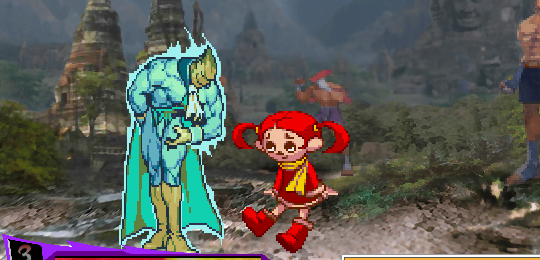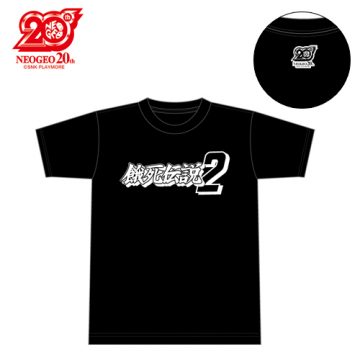Gamest was one of the many video game magazines that ran through the 80s up until 1999, primarily created for arcade enthusiasts, but it was also known for its many, many typos. The most amusing of these was actually canonized by Capcom.
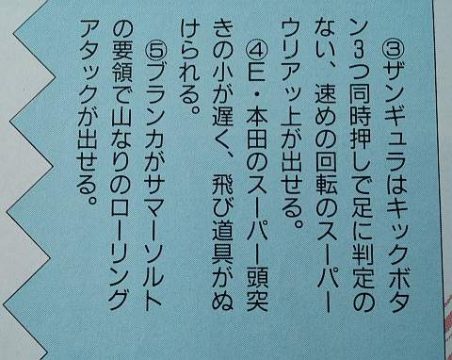
In the January 1993 issue, in reference to one of Zangief’s special moves, they made two ridiculous errors in the same sentence. First, “Zangief” (ザンギエフ) was misspelled as “Zangyura” (ザンギュラ), and secondly, the name of the move, which should have been “Super Lariat” (スーパー ラリアット) but ended up as “Super Uriajjou” (スーパーウリアッ上). That move name is almost complete gibberish, primarily because it ends the word with a kanji character rather than katakana.
These typos do make more sense when you consider how similar the characters look:
エ→ュ、- “e” -> “yu”
フ→ラ、- “fu” -> “ra”
ラ→ウ – “ra” -> “u”
ト→上 – “to” -> kanji meaning “up”, read as “jou” or “ue”
Gamest actually made the same typo AGAIN when sticking his name in a character poll.
It didn’t help that the name was actually wrong, since it changed from “Super Lariat” in the location test to “High Speed Double Lariat” in the final version, though that wasn’t their fault.
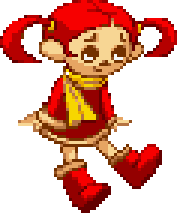
Anyway, Dmitri from the Darkstalkers games has an attack called Midnight Bliss, which will temporarily change his opponent into different forms. In Capcom Fighting Evolution, if you use this attack on Zangief, he’ll turn until a little Russian girl, seen above. According to the (now defunct) official website for the game, this is Zangyura-chan, named after the famous typo, with a design based on the Russian cartoon character Cheburashka, a monkey-like creature.
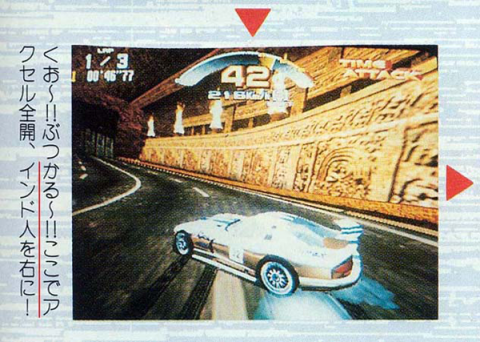 This is probably the most famous Gamest typo, but there have been many others, of course. One of the most amusing is in issue 193, in reference to Sega’s SCUD Race, where the sentence reads “Hit the accelerator full throttle here, Indian to the right!” (ここでアクセル全開、 インド人を右に) The misspelled word should have been “handle” (ハンドル), the word typically used for “steering wheel”, rather than “Indian” (インド人), so it’s meant to say “turn the handle to the right!” (Verbs are sometimes omitted in Japanese when the meaning is obvious, though here the ambiguity adds to the comedy.) This has since become a Japanese meme in its own right. Sega actually paid tribute to the phrase in their 2015 rhythm game Chunithm, with a song called “The wheel to the right” (written in English).
This is probably the most famous Gamest typo, but there have been many others, of course. One of the most amusing is in issue 193, in reference to Sega’s SCUD Race, where the sentence reads “Hit the accelerator full throttle here, Indian to the right!” (ここでアクセル全開、 インド人を右に) The misspelled word should have been “handle” (ハンドル), the word typically used for “steering wheel”, rather than “Indian” (インド人), so it’s meant to say “turn the handle to the right!” (Verbs are sometimes omitted in Japanese when the meaning is obvious, though here the ambiguity adds to the comedy.) This has since become a Japanese meme in its own right. Sega actually paid tribute to the phrase in their 2015 rhythm game Chunithm, with a song called “The wheel to the right” (written in English).
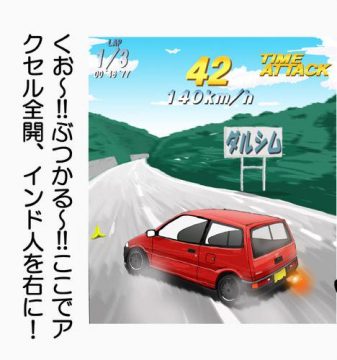
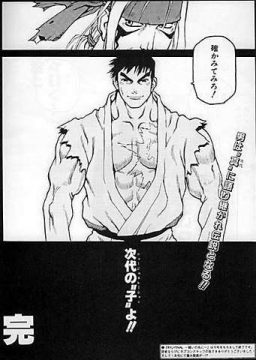
This here is the Ryu Final manga, that was published in Gamest – not even the comics were free from errors. Right at the end, in the final chapter, Ryu says:
INCORRECT:
確かみてみろ!
Tashika mitemiro! – “Try to makp sure of it!”
CORRECT:
確かめてみろ!
Tashika metemiro! – “Try to make sure of it!”
This is famous because this was supposed to be a dramatic reveal but instead it’s just ruined with the typo.
That’s not the only one: there was even a typo right on the first page, when introducing the author:
INCORRECT:
中平正彦宣誓執筆! – Written by Nakahira Masahiko-Sensei (as in “oath”, the word is pronounced the same but the kanji and the meaning are totally different)
CORRECT:
中平正彦先生執筆! – Written by Nakahira Masahiko-Sensei! (as in “master”, general term of respect)
The joke is that Ryu Final was the manga that began with a typo and ended with a typo, thus making the circle complete. These errors were fixed for the compiled tankoubon release, at least. It was also eventually released in English in 2007 by Udon, though this book is long out of print.
Other infamous cases found through their various magazines, mooks, and other published material are when they referred to the Capcom action game Senjou no Ookami (戦場の狼, “Wolf of the Battlefield”, known in English as Commando) as “Senjou no Saru” (戦場の猿, “Monkey of the Battlefield”), and “Crouching Fierce Punch” (しゃがみ大パンチ) as “Crouching Large Panties” (しゃがみ大パンツ). (“大” technically means “large” or “strong” but in the context of Street Fighter II moves it’s translated as “fierce”). One time they spelled Street Fighter Zero 3 as “ZStreet Fighter Ero 3” (“ero” of course being short for “erotic”, an English word typically used even in Japanese to refer to porn.)
They also misspelled Garou Densetsu (餓狼伝説), the Japanese name for Fatal Fury, meaning “Legend of the Hungry Wolf”, as both Gashi Densetsu (餓死伝説), meaning “Starvation Legend” and Kiga Densetsu (飢餓伝説), meaning “Hunger Legend”. You can even buy a Starvation Legend t-shirt if you want, along with some of the other titles mangled by the magazine, including Choku Samurai Spirits (直サムライスピリッツ, “Straight Samurai Spirits”) instead of Shin Samurai Spirits (真サムライスピリッツ “True Samurai Spirits”, the title of Samurai Shodown 2), or Samurai Spirits Amakusa System (サムライスピリッツ天草システム) instead of Samurai Spirits Amakusa Kourin (サムライスピリッツ 天草降臨, “Amakusa’s Descent”, translated as “Amakusa’s Revenge” in English, the fourth game in the series). Some more famous typos are listed here.
Back in these days, the manuscripts were typically handwritten, so the editors of the magazine blamed the department that converted the text for the magazine for messing it up. But in general, it didn’t help that the contributors were typically gamers with no real editorial experience, and the people converting the text may not have had any idea about video game lingo to make sure it was correct. Plus, it was also apparent that no one actually proofread much of anything before the magazines went out the door.
Thanks to Hanenashi Error for his help with some of these translations!
Links to sources:
https://web.hackadoll.com/n/
http://dic.nicovideo.jp/a/
https://www.vgfacts.com/forums/thread-3931.html
https://www49.atwiki.jp/aniwotawiki/pages/17434.html
https://kakuge.com/wiki/pages/%E3%82%B2%E3%83%BC%E3%83%A1%E3%82%B9%E3%83%88
http://kakuseix.com/main/mest.html
